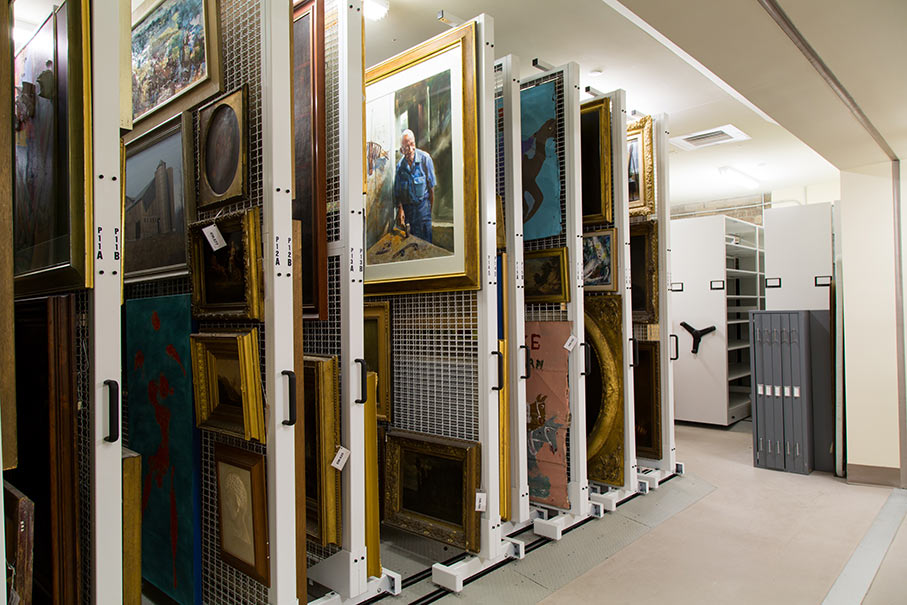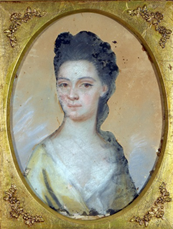As an intern at the Gibbes, one of the best parts of my job is getting an up-close view of what goes on behind the scenes at the museum. While following around Zinnia Willits, Director of Collections Administration, I’ve learned all about how the collection is handled, organized, preserved, and stored. Though the gallery walls appear to hold plenty of paintings, thousands more objects are in storage. I know I’m not the only one who’s curious about that room with glass walls on the third floor at the Gibbes—I often see visitors peering in, wondering what’s going on back there. I talked to Zinnia and our Curator of Collections, Sara Arnold, to answer some questions about how, where, and why the Museum stores the rest of its art.
Like most museums, 95% of the Gibbes Museum’s collection is in storage. In boxes, bins, shelves, and racks, most of the 8,000 objects remain safely stowed behind closed doors. Part of the Gibbes’ Museum renovation includes a new storage space, located on its third floor. Through its large glass walls, visitors can glimpse tall metal racks stocked with hanging paintings, rows of narrow boxes with neat labels, and specially equipped cabinets which hold the extensive miniature portrait collection.
The Gibbes can now store all of its collection and archives in one location, instead of relying on multiple off-site storage areas. This room was specifically designed for art storage with maximum efficiency and safest conditions. No wood fixtures are used, which eliminates risk of insect infestation. Instead, artwork only comes in contact with powdered metal and acid-free materials. The space also provides room for the collection to grow and expand.
The new storage room includes moveable wire racks for hanging paintings, secure cabinets for storing miniatures and silver, solander boxes (book-shaped hardcover case with a hinged lid) to protect works on paper, and assorted metal shelves. The lights have a UV filter and especially light-sensitive works are preserved in protective solander boxes. Temperature and humidity are controlled by a separate HVAC system, which keeps conditions stable to preserve the artwork.

The objects are organized with an individual identification number, using an international system based on the year in which the object was acquired. The Gibbes’ collection database records important information for each object, including dimensions, condition, provenance, and current location. Much of the collection database is accessible online, through the Gibbes website.
The new storage room also provides space for safely handling the collection. Before going on display, pieces can be cleaned, matted, and framed. Condition reports and minor conservation can be conducted on the large central table. Objects can be photographed for cataloguing and research. There is also plenty of space for packing and unpacking artwork. On any given day, you may find staff here, working on various projects involving the collection. Behind the scenes tours will soon be available to give visitors an in-depth view of how the Gibbes’ stores, manages, and conserves its artwork.

The Museum seeks to provide education and enjoyment of its collection, both through displaying artwork and preserving it for future research. Only about 5% of the permanent collection can be displayed. Curators decide which art to put on view by developing exhibitions that best allow the Gibbes Museum to tell its story. Focusing on the richest areas of the collection, curators choose works of art that provide a chronological overview of American art from a Southern perspective.
From political figures and military leaders to family members and loved ones, the Gibbes’ broad portraiture collection offers names, faces, and a personal view into American art history. A range of 20th-century artwork by both visiting and local artists provides a colorful account of the Charleston Renaissance. The contemporary collection brings the Gibbes’ story to present day, featuring influential artists who explore present day issues.

The permanent collection on display is rotated every six months. Works that are particularly susceptible to light damage are rotated more frequently to preserve their condition. More sustainable media, such as oil on canvas, can stay on view for longer periods of time. Collection favorites, such as Pietro Rossi’s Veiled Lady and Childe Hassam’s The Green Gown are kept on view as much as possible.
When not on view, artwork is preserved in storage space for future research, scholarship and cataloguing. Each object is stored using material best suited to conserve its condition. The new storage space includes ideal storage material for the medium and condition of the artwork. For example, photographic negatives are preserved in a freezer. Most date to before 1940, and materials used at the time were acetate and nitrate. Putting the negatives in cold storage extends their lifespan drastically.
Some artwork in the collection is too fragile to be exhibited before further conservation, such as fragile pastel portraits from the early 18th century. Although they can’t yet be displayed in the galleries, these objects are valuable for research and contributing to scholarship.

In addition to increased space efficiency and improved preservation methods, the new storage space also allows the Museum to give visitors a window into what goes on behind the scenes. As in most museums across the world, the majority of the collection is not on view to the public. By installing large glass panes in the front of the storage room, the Gibbes invites visitors to learn about how the collection is stored, organized, managed, and conserved.
—Sarah Russell, Gibbes Museum of Art Summer Intern
Published June 30, 2016

